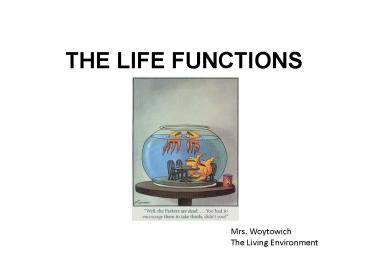THE LIFE FUNCTIONS PowerPoint PPT Presentation
1 / 20
Title: THE LIFE FUNCTIONS
1
THE LIFE FUNCTIONS
Mrs. Woytowich The Living Environment
2
OBJECTIVESUpon completion of this unit students
will be able to
- 1. Correctly identify and define the eight life
functions of organisms - Respiration
- Regulation
- Reproduction
- Excretion
- Growth
- Nutrition
- Transport
- Synthesis
- 2. Explain the differences between each of the
following - Unicellular organisms Multicellular organisms
- Asexual Reproduction Sexual Reproduction
- Aerobic Respiration Anaerobic Respiration
- Absorption Circulation
- Autotrophic Nutrition and Heterotrophic Nutrition
- Ingestion vs. Digestion vs. Egestion
- 3. Define the term metabolism and relate it to
the functioning of an organism.
3
KEY TERMS
- Absorption
- Aerobic respiration
- Anaerobic respiration
- Asexual reproduction
- ATP
- Autotrophic nutrition
- Circulation
- Digestion
- Excretion
- Glucose
- Growth
- Heterotrophic nutrition
- Homeostasis
- Ingestion
- Insulin
- Metabolism
- Nutrients
- Nutrition
- Organism
- Regulation
- Respiration
- Sexual reproduction
- Synthesis
- Transport
4
A. CHARACTERISTICS OF LIFE
- Biology is the STUDY OF LIVING THINGS
- All living things have ALL (not just some) of the
characteristics of life. - All living things show a great deal of DIVERSITY
(DIFFERENCES) but also have many characteristics
in common. In other words, they show UNITY
(SIMILARITIES). - Each living thing is called an ORGANISM.
5
There are eight things that all living things
(ORGANISMS) have in common
- LIVING THINGS ARE HIGHLY ORGANIZED AND CONTAIN
MANY COMPLEX SUBSTANCES - LIVING THINGS ARE MADE UP OF ONE (UNICELLULAR) OR
MORE (MULTICELLULAR) CELLS. A CELL IS THE
SMALLEST UNIT OF LIFE - LIVING THINGS USE ENERGY
- LIVING THINGS HAVE A LIMITED LIFE SPAN
- LIVING THINGS GROW
- LIVING THINGS RESPOND TO CHANGES IN THE
ENVIRONMENT - LIVING THINGS ARE ABLE TO REPRODUCE
- LIVING THINGS CHANGE OVER TIME
6
- ALL LIVING THINGS POSSESS ALL OF THESE
CHARACTERISTICS. NONLIVING THINGS ARE CLASSIFIED
AS NONLIVING BECAUSE THEY DO NOT POSSESS ALL OF
THEMALTHOUGH IT IS POSSIBLE FOR THEM TO POSSESS
SOME!
7
B. THE LIFE FUNCTIONS
- Scientists have been unable to agree on a single
definition of life, but do agree on what the
signs of life are. Thus, we will now discuss the
8 life functions. - What are they? R RESPIRATION
- R REGULATION
- R REPRODUCTION
- E EXCRETION
- G GROWTH
- N NUTRITION
- T TRANSPORT
- S SYNTHESIS
- R-R-R-E-G-N-T-S
8
1. RESPIRATION
- INVOLVES RELEASING CHEMICAL ENERGY FOUND IN
NUTRIENTS - Organisms need materials and energy to stay ALIVE
- An organism uses energy and a constant supply of
materials to PERFORM ALL LIFE FUNCTIONS - The two types of respiration are
- Aerobic Respiration USES O2
- Anaerobic Respiration DOES NOT USE O2
9
RESPIRATION
10
2. REGULATION
- INVOLVES CONTROLLING AND COORDINATING VARIOUS
ACTIVITIES - Animals have
- Nervous system CARRIES NERVE MESSAGES
(IMPULSES) - Endocrine system - CARRIES CHEMICAL MESSAGES
(HORMONES) - Plants have PARTS THAT PRODUCE HORMONES, BUT NO
NERVOUS SYSTEMS
11
3. REPRODUCTION
- INVOLVES AN ORGANISM PRODUCING NEW ORGANISMS OF
THE SAME KIND - Is reproduction necessary for the continued
existence of an organism? NO Is reproduction
necessary for the continued existence of a
species? YES-THE SPECIES WILL DIE OUT (EXTINCT)
IF IT STOPS PRODUCING - The two types of reproduction
- ASEXUAL - ONE PARENT ALL OFFSPRING IDENTICAL TO
THE PARENT - SEXUAL - TWO PARENTS OFFSPRING NOT IDENTICAL TO
EITHER PARENT
12
Can you identify the types of reproduction?
13
4. EXCRETION
- INVOLVES THE REMOVAL OF WASTES FROM AN ORGANISMS
BODY
NH3
NH3
H2O
H2O
H2O
H2O
NH3
H2O
NH3
(METABOLIC WASTES)
14
5. GROWTH
- INVOLVES AN INCREASE IN SIZE
- There is a difference between growth and
development
15
- NUTRITION
- INVOLVES TAKING MATERIAL FROM THE ENVIRONMENT
- AND PUTTING IT INTO USABLE FORMS
- There are two types of nutrition
- Autotrophic Nutrition MAKE THEIR OWN FOOD
(EXAMPLE - PLANTS)
- Heterotrophic Nutrition CANNOT MAKE THEIR OWN
FOOD - Heterotrophic nutrition involves
16
- TRANSPORT
- INVOLVES SUBSTANCES ENTERING AND LEAVING CELLS
- AND BECOMING DISTRIBUTED WITHIN CELLS
- Transport involves
17
- SYNTHESIS
- SIMPLE SUBSTANCES ARE COMBINED TO MAKE COMPLEX
- SUBSTANCES
EXAMPLE Dehydration Synthesis
MONOSACCHARIDE MONOSACCHARIDE
18
- C. METABOLISM
- ALL THE CHEMICAL REACTIONS OCCURRING WITHIN THE
CELL(S) OF AN ORGANISM - R R R E G N T S METABOLISM
19
- D. HOMEOSTASIS
- THE CONDITION OF A CONSTANT, STABLE INTERNAL
ENVIRONMENT - Organisms need to keep their internal conditions
relatively stable to survive (Examples fever,
diabetes). - The process of maintaining a stable internal
environment is called HOMEOSTASIS - If homeostasis is disrupted in a major way, an
organism cannot survive!
20
- E. EVOLUTION
- AS A GROUP (not individually), species change, or
EVOLVE over time. - F. BRANCHES OF BIOLOGY
- The many levels at which life can be studied
include (from smallest to largest) - CELLS ? TISSUES ? ORGANS ? ORGAN SYSTEMS ?
ORGANISM ? POPULATION ? COMMUNITY ? ECOSYSTEM ?
BIOSPHERE - ?

